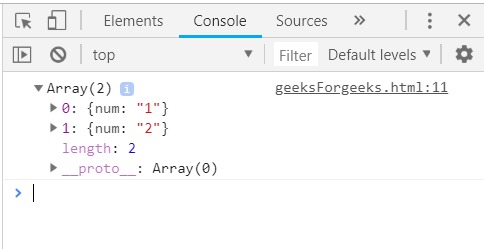Underscore.js是一個JavaScript庫,提供了許多有用的函數,即使在不使用任何內置對象的情況下,也可以極大地幫助您進行編程,例如映射,過濾,調用等。
_.first()函數用於返回數組的第一個元素,即第零個索引處的數字。它返回大小為m的數組中的前n個元素(n
用法:
_.first(array, [n])
參數:該函數接受上麵提到並在下麵描述的兩個參數:
- array:此參數用於保存元素數組。
- variable:它告訴想要的元素數量。
返回值:此函數返回元素數組。
將數組傳遞給_.first function():._first()函數將返回第一個元素以及所傳遞數組的所有屬性。像這裏一樣,元素具有2個屬性(名稱和年齡),因此最終結果將包含第一個元素的這兩個屬性,因為變量n不在此處傳遞。
例:
<html>
<head>
<script type="text/javascript" src=
"https://cdnjs.cloudflare.com/ajax/libs/underscore.js/1.9.1/underscore.js"></script>
</head>
<body>
<script type="text/javascript">
console.log(_.first([{name: 'jack', age: 14},
{name: 'jill', age: 15},
{name: 'humpty', age: 16}]));
</script>
</body>
</html> 輸出:

將結構傳遞給_.first()函數:._first()函數將返回第一個元素以及所傳遞數組的所有屬性,因為此處未傳遞變量n。像這裏一樣,每個元素都有四個屬性,類別,標題,值和id。因此,最終結果將包含第一個元素的所有這些屬性。
例:
<html>
<head>
<script type="text/javascript" src =
"https://cdnjs.cloudflare.com/ajax/libs/underscore.js/1.9.1/underscore-min.js" >
</script>
</head>
<body>
<script type="text/javascript">
var goal = [
{
"category" : "other",
"title" : "harry University",
"value" : 50000,
"id":"1"
},
{
"category" : "traveling",
"title" : "tommy University",
"value" : 50000,
"id":"2"
},
{
"category" : "education",
"title" : "jerry University",
"value" : 50000,
"id":"3"
},
{
"category" : "business",
"title" : "Charlie University",
"value" : 50000,
"id":"4"
}
]
console.log(_.first(goal));
</script>
</body>
</html>輸出:

將具有一個屬性為true /false的數組傳遞給_.every()函數:這將與上述兩個示例完全相同。 false /true屬性將僅顯示第一個元素。在此,將不會在邏輯上使用此屬性。
例:
<html>
<head>
<script type="text/javascript" src =
"https://cdnjs.cloudflare.com/ajax/libs/underscore.js/1.9.1/underscore-min.js" >
</script>
</head>
<body>
<script type="text/javascript">
var people = [
{"name": "sakshi", "hasLong": "false"},
{"name": "aishwarya", "hasLong": "true"},
{"name": "akansha", "hasLong": "true"},
{"name": "preeti", "hasLong": "true"}
]
console.log(_.first(people));
</script>
</body>
</html>輸出:
將具有變量n的數組傳遞給_.first()函數:要具有多個元素(即第一個元素),隻需傳遞數字並得到結果。請記住,元素將始終來自數組的開頭。
例:
<html>
<head>
<script type="text/javascript" src =
"https://cdnjs.cloudflare.com/ajax/libs/underscore.js/1.9.1/underscore-min.js" >
</script>
</head>
<body>
<script type="text/javascript">
var users = [{"num":"1"}, {"num":"2"},
{"num":"3"}, {"num":"4"}, {"num":"5"}];
console.log(_.first(users, 2));
</script>
</body>
</html>輸出:

相關用法
- JQuery eq()用法及代碼示例
- underscore.js where()用法及代碼示例
- JQuery has()用法及代碼示例
- underscore.js every()用法及代碼示例
- JQuery on()用法及代碼示例
- JQuery after()用法及代碼示例
- underscore.js _.last()用法及代碼示例
- JQuery last()用法及代碼示例
- JQuery first()用法及代碼示例
- underscore.js _.zip()用法及代碼示例
- underscore.js _.without()用法及代碼示例
- underscore.js map()用法及代碼示例
- JQuery one()用法及代碼示例
- JQuery val()用法及代碼示例
- underscore.js min()用法及代碼示例
注:本文由純淨天空篩選整理自Sakshi98大神的英文原創作品 Underscore.js | first() with Examples。非經特殊聲明,原始代碼版權歸原作者所有,本譯文未經允許或授權,請勿轉載或複製。
